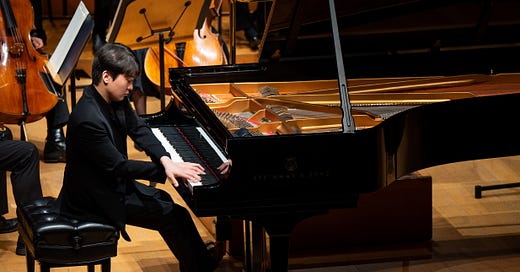A Reflection on Schoenberg at 150: Paavo Järvi and the LA Philharmonic with Seong-Jin Cho
This first guest post by Janelle Kim reviews intense polarities of music in a night of Schoenberg, Ravel and Grażyna Bacewicz at Walt Disney Concert Hall, LA.
Dear Readers,
In great anticipation of more international critiques, I am thrilled to present Crepuscular Music’s LA classical music correspondent Janelle Kim.
Janelle recently received her MA in Writing from the University of Exeter but she is a Southern California native. Her love for classical music began in high school, where it was fostered by the thriving orchestra scene in Orange County. At UC San Diego she co-founded the first student-run literary magazine while receiving her bachelor's degree in English Literature, and she continued learning and writing more about classical music, including opera. She has conducted and published interviews on artists from San Diego, Los Angeles, and London.
Here is Janelle’s review of Friday night’s Walt Disney Concert Hall concert featuring Paavo Järvi and pianist Seong-Jin Cho.
Enjoy!
Sophia
Seong-Jin Cho at the keys. Photographs taken by Elizabeth Asher at the Walt Disney Concert Hall, provided courtesy of the Los Angeles Philharmonic Association.
Despite this concert taking place on Valentine’s Day, there was no catering to the holiday with a romantic or intimate opening piece. Arguably, the most romantic aspect of this evening’s commencement was the dimming of the Walt Disney Concert Hall lights. The LA Philharmonic dove headfirst into an energetic full string orchestra performance of Bacewicz’s “Concerto for String Orchestra.”
The first movement was an explosive start to the night, crisp and polished. Although Bacewicz’s “Concerto for String Orchestra” kept the orchestra divided in parts and countermelodies, the orchestra displayed excellent unity and control under conductor Paavo Järvi. With a piece like this, full of snappy dynamic changes and quick transitions between pizzicato and arco, it was a delight to witness unfalteringly clean execution between ensemble and conductor. This mastery continued on full display through the second and third movements, and there was no shortage of fantastic soloists. One highlight was the solo at the beginning of the second movement: the violist perfectly set the mood and tone for the rest of the haunting “Andante” section.
A handful of reed, woodwind, brass, and percussion musicians joined the strings for Ravel’s “Piano Concerto in G.” As the piano was wheeled into the center, the audience fell silent. Then, to a loud and thunderous round of applause, guest pianist Seong-Jin Cho took his seat. The concerto started off with a bang – or rather, with a sharp whip of the slapstick. Immediately, a rapid exchange between piano and piccolo evolved. Cho was precise and expressive, unafraid to use an occasional flourish to emphasize the movements of his hands flurrying around the keys. He often leant over them as he came to the end of a particularly difficult section.
Ravel’s love for American jazz is apparent in this piece, which is full of moments of dissonance that ultimately resolve into passages that burst forward with brightness like a wintered forest opening up to the first hint of spring sunlight. In the “Adagio assai,” building tension and quiet tenderness were perfectly matched, and so were Cho’s solos with the various reeds and woodwinds. The third and final movement was equally brilliant – leaving an overall impression of a wandering, sometimes even scampering, melody. Oftentimes, pieces like this can be an acquired taste, especially since some might find the rapid changes of the third movement too easily comparable to chaos. However Paavo Järvi found unity in this chaos, keeping the piano soloist, orchestra, and band all tightly interwoven.
With a handful more band instruments than in the Ravel, the Philharmonic swayed and danced excellently through “Piano Quartet No. 1 in G minor" (Op. 25). If the Ravel was like a bursting forest, Schoenberg’s orchestrated version of a Brahms piano quartet began like a small grove of trees undulating in the gales of an unexpected summer storm. The orchestra easily navigated the first three movements; caressing mellow and peaceful moments and occasionally unearthing pockets of tension. The melody cascaded through the winds, the strings followed and for a brief moment there was a flash of unison, which fell away in perfect synchronicity.
Eventually the finale began and the atmosphere changed. The music was undeniably exhilarating and jaunty – I caught more than a few heads bobbing along with the beat set by percussionists whose bodies seemed markedly more animated than before. With this final and lively piece, each section had its own moment to shine, and the night ended with the same burst of energy with which it had begun, if not even greater.





